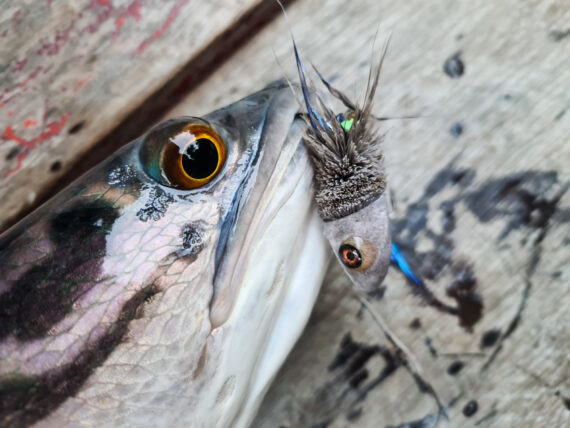Sebarau on Popper Fly
The sebarau is one of the more exciting fresh water gamefish to target on fly, especially on surface fly. The take of the sebarau on surface fly is always exciting, providing a sensory overload from the visual, auditory and kinesthetic sense. The best time to target them on surface is in the early mornings and late evenings, where they will be actively hunting on the surface for any unsuspecting prey such as grasshoppers, spiders or any unfortunate insects that get blown onto the water. The use of large noisy poppers in bright colours, decorated with flashy tinsels and enhanced with UV flash works best. In the early morning, we would cruise the banks of the waterway where there is thick vegetation and if there is a tree that has fallen into the water, that’s the best place to find them hunting actively. Once we have located a likely spot, we would shut down the boat engine and slowly drift into position, careful not to drift too close. The boat will be drifting parallel to the bank about 50 to 60 feet away. We would pick a target, usually a tree trunk partly submerged or a clump of vegetation and cast to it. Once the ripple has settled, the line is stripped in a short burst and rod tip is twitched to enhance the action and the commotion of the popper. The trick here is to “ pop”, stop and then “pop” again. This action allows the popper to remain in the strike zone longer while giving time for the sebarau to examine the fly. They usually take the fly when it starts moving. There are times when they will follow the fly close to the boat and take the fly before diving down into the deeper water. Sometimes, the sebarau will take the popper on the drop if it lands near them. It is important to hang on the line at the last cast so that your hand is always in contact with the line. Some people would just let go of the line and let it fly out, adding distance to the cast. While this is good if you are distance casting, but to catch fish, the hand needs to always be in contact with the line, ready to strip strike when the fish take the fly. Lifting the rod to strike like when doing conventional fishing will only pull the fly out from the fish’s mouth. In the late evenings, the sebarau will hunt in groups and it is this behavior that gives them the name River Wolves. They can be seen charging at helpless baitfish near the surface and it takes speed, accuracy and a cool head to cast to them. In this situation, once the popper lands, start popping fast and hard. A strike usually doesn’t take very long. ~More Gallery Click Here~


